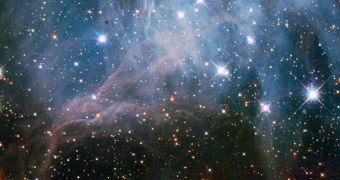Astronomers operating the NASA/ESA Hubble Space Telescope release a new image of a loosely-bound-together stellar cluster in the Large Magellanic Cloud dwarf galaxy. The latter is one of Milky Way's galactic satellites.
The stellar grouping, called LH 88 or NGC 2040, is one of the largest known formations of this type. Hubble imaged it as part of series of photos it snaps to celebrate its 22nd anniversary. The famous telescope was launched into orbit back in 1990.
Most of the stars visible in the new image are part of LH 88 and appear to be covered by haze. The cloud is made up of hydrogen and diminutive traces of other gases. Astronomers say that members of this star cluster move through space together, but interact only marginally.
The cluster is cataloged as an OB association, which implies that it is made up of 10 to 100 type O and type B stars. According to scientists, most of the stars in the Milky Way, including the Sun, originated in such associations.
Hubble used its Wide Field Planetary Camera 2 (WFC-2) instrument to capture this image. The cluster is located in the LMC, which is one of the largest satellite of the Milky Way, alongside the Small Magellanic Cloud.
There are many dwarf galaxies orbiting the Milky Way, scientists say, a lot more than the ones observed until now. Computer models indicate that our galaxy may be accompanied by tens or hundreds of these structures.
Detecting them is a very complex process, which explains why only the largest of them have been identified and cataloged. The LMC, for example, features many well-known structures, such as the Tarantula Nebula, as well as numerous clusters.
As an OB association, LH 88 is made up of massive stars. These objects lead short lives, and tend to end their main sequence by exploding as supernovae. When this happens, their brightness exceeds that of their host galaxy, as seen from Earth.
Many of the stars in LH 88 are located within the supergiant shell of gas called LMC 4. The hydrogen gas in this structure is partially ionized, and used to create new stars. According to estimates, LMC 4 still has enough gas to form several thousands stars.

 14 DAY TRIAL //
14 DAY TRIAL //